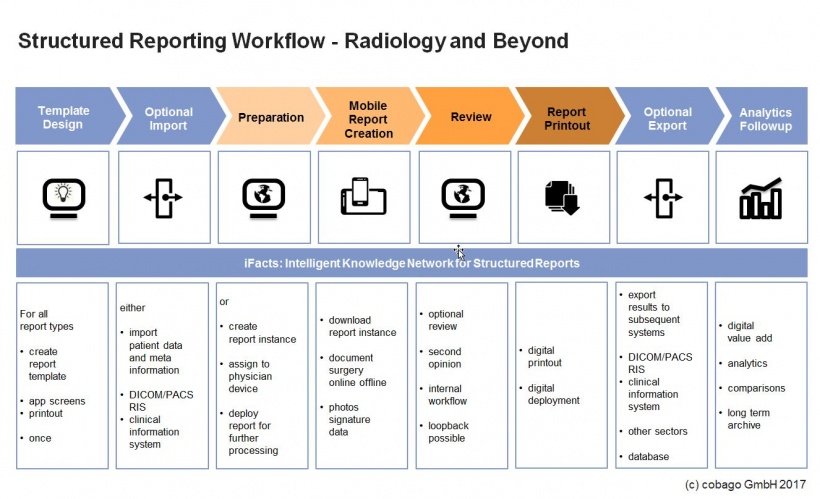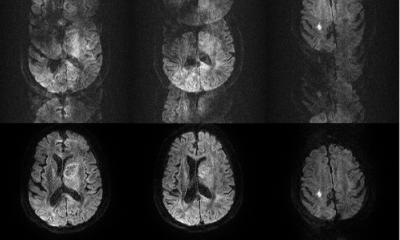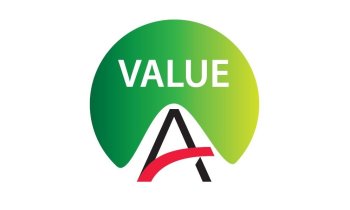
Article • The power of mobile intelligent information systems
Structuring data collection and diagnosis
Today’s healthcare IT market offers myriads of so-called comprehensive solutions to digitise administrative processes. However, in real life, long and verbose diagnoses and medical findings - and even paper-based documentation - are still widespread.
To meet regulations, generating written findings and reports account for over half of a hospital’s daily work. Radiologists need greater efficiency due to increasing costs and competition. To that end, mobile IT specialist cobago has developed cobago SIX, to provide instant structured reporting and workflow management.
‘The “classical way" is not only time-consuming but highly error-prone,’ the firm points out. ‘Reports also consist of multiple media types, such as texts, DICOM images and other data. This complicates central archiving and re-use in subsequent processes: It´s high time to use the power of mobile and intelligent information systems to increase the efficiency of medical staff and increase overall documentation quality.’
cobago SIX turns tablet computers into mobile digital assistants for documentation and valuation of medical facts on-site and in a doctor´s office.
‘Due to its architecture and function, SIX is optimal for structured data collection and diagnosis in radiology and other medical faculties. At first SIX offers structured scheme based fact collection, image adding, signature and auto-forwarding – this all based on intelligent case-dependent (case-aware) self-modifying checklists. Based on this, SIX automatically creates uniformly structured documents and, in parallel, digital data for subsequent analytics, comparative evaluation and handover to third party medical information systems.’
As an example, cobago reports, ‘a SIX checklist documents a CT or MRT of the thorax with suspected carcinoma. The radiologist - using his tablet - completes a predefined thorax carcinoma checklist with the respective parameters. These may include written or spoken text, numbers, checkboxes and dropdown text selectors, as well as signatures, files and images. Important key indicators are calculated and plausibilities are checked straightaway. Non conformities and errors are automatically identified and can be corrected at once.’
Automated collection, valuation, analytics and retrieval
Due to its architecture and function, SIX is optimal for structured data collection and diagnosis in radiology and other medical faculties.
Dr. Dieter Kramps
‘In the subsequent workflow, the signed document is transferred to a central location. Here a complete, semantically correct and ready to print report of text elements plus embedded photos and signatures is automatically generated. All data are additionally stored in a database and can be analysed one by one or as a whole,’ the company adds.
cobago SIX is an open, highly flexible, customisable ecosystem. ‘It can be easily adapted to different medical use cases and requirements, starting with the definition of checklists and ending with gateways to third party information systems and subsequent processes, on-site or at other sector locations,’ cobago points out. ‘For this reason the SIX ecosystem can not only be adjusted to different content and processual requirements but also seamlessly integrated into virtually any hospital IT infrastructure.’
Thus diagnosis quality is optimised, results categorised and standardised, and findings become comparable and digitally searchable - without any further action of a physician, the report points out.
Obvious advantages

Productivity increases for a given staff, process cost decreases - through reduction of data collection errors and more so through growing transparency of the whole radiologic examination process, cobago adds. ‘Team members are able to focus even more on the patient and their own core competencies, rather than fighting the perfidy of different tools for texting, layout and data storage. Central organisation and IT benefit from unified digital formats, reliable and precise examination documentations, from automatic compliance to regulations and standards - and from complete accounting information records.’
Profile:
Dr. rer. nat. Dieter Kramps has more than 25 years of ITC experience in management and executive positions. Today he is CEO of the mobile specialist cobago GmbH, focussing on cross industry mobile solutions, IoT, cloud, security and predictive analytics. He worked on pioneer electronic patient records, assisted T-Systems and VISUS in introducing a long term archiving cloud service, worked for MATERNA, mbp (later EDS) and VEW. Dr. Kramps studied Computer Science/Electrical Engineering in Dortmund and received his degree as Dr. rer. nat. in Hagen.
14.11.2017











